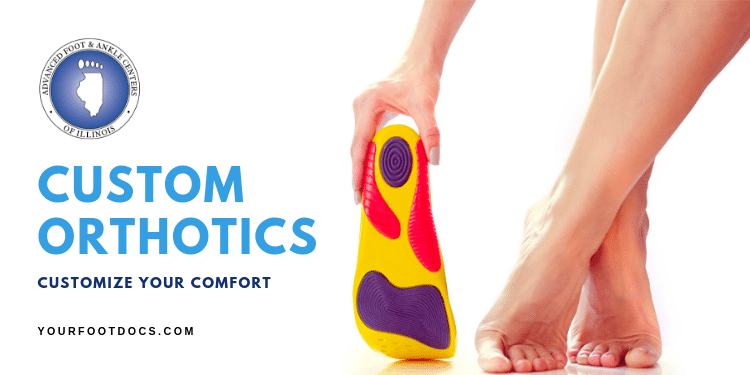Customize Your Comfort
This may come as a surprise to some, but your feet are actually one of the most fascinating parts of your body. Don’t believe it? Let us enlighten you.
Just as with your hands and wrists, your feet and ankles are complicated structures—they contain more than 26 of the 206 total bones which make up your body structure. If we include their respective muscles, ligaments and tendons, the count of anatomical components easily goes up into the hundreds.
Combine all those elements and you have feet that are not only capable of sustaining your bodyweight, but are also strong enough to propel your body forward as you walk, run, dance, and do the things you love to do.
At the same time, your lower limbs are also flexible enough to adapt to sudden surface changes as our body moves through a world that doesn’t always have the most stable of surfaces—especially in our Midwest winters!
Looking at the bigger picture, your feet are the foundation to your skeleton. As such, if your feet suffer, so do the rest of your bones, joints, etc. That should make sense because if your foundation isn’t aligned properly, other areas of your structure will also be thrown off balance. This can easily affect your knees, back, and even neck.
One could almost say that your health should be evaluated from the ground up, feet first. And, if we determine that your lower limbs are not “working” properly, then a potential (and easy) solution may be to prescribe you a pair of custom orthotics.
Customize Your Comfort
If you happen to fall within the 70-80% of human population whose feet don’t quite align correctly, then orthotics may be a good choice for you.
There are two general types of orthotics:
- Generic Shoe Inserts. These can be store-bought and are less specific to your needs (i.e.: Dr. Scholl’s). Generic shoe inserts don’t correct substantial biomechanical flaws or cure foot issues long-term but may have value in providing additional support and cushioning in your shoes.
- Custom-Molded Orthotics. These medical devices are molded to fit an individual’s specific need (unique to one’s foot). In order to determine the type of orthotics needed, the podiatrist conducts in-depth evaluation of the individual’s diagnosis.
- Accommodative Orthotics. This type of custom orthotics is made to provide extra cushion and support. They are essentially the basic version of custom orthotics aimed to treat and prevent arthritis, ulcers, pain, and deformities.
- Functional Orthotics. This type of custom orthotics, on the other hand, are made to correct improper movements, like your gait. Because of this, functional orthotics are made of semi-rigid materials – although, softer materials may also be an option – to ensure that your feet and ankles keep a healthy alignment.
As you can likely see, custom-molded orthotics are undoubtedly more efficient for correcting foot problems, since they focus specifically and uniquely on aligning the feet for which they are molded.
And what works better than something that was made just for you?
Customizing Your Orthotics
There are various methods podiatrists can use when customizing orthotics for their patients. Here at Advanced Foot & Ankle Centers of Illinois, we have an advanced method we’re quite proud to offer—digital scanning.
Specifically, we use Forward Motion 3D scanning technology. As we do, we are able to easily scan your entire foot and then review the scan to ensure accuracy. It’s incredibly quick and easy, and there’s no mess you might expect when you learn your foot is going to be casted for a pair of orthotics.
Who Should Consider Custom Orthotics?
Simply put, just about everyone should at least consider custom orthotics if they are suffering from foot or ankle pain. After all, we’re talking about versatile medical equipment that can be used to address a wide range of foot and ankle issues.
One that tends to be especially prominent when it comes to orthotic therapy is overpronation.
If you don’t know what that is, let’s take a quick look at pronation:
Whether or not you’re aware of this, feet are supposed to rotate inwards about fifteen percent. The foot arches play a big role in this—and when they are low (flatfoot), it leads to excessive rotation.
Okay, so why is that bad? Basically, if you overpronate, you put excessive pressure on an area of the foot that’s not supposed to receive it. In this case, we’re talking about the inner, front edge of the foot, and especially where the big toe connects (the metatarsophalangeal joint).
This can be a problem because it causes pain in the forefoot and increases the likelihood of bunion development. (And it can exacerbate an existing condition.)
Orthotics can improve biomechanical processes—such as pronation—and take away the pain and discomfort they cause. One particular group who really appreciates this is the running population!
Other individuals may want to consider custom orthotics, however, so that they can better distribute their bodyweight onto their feet, relieve pressure on their heels and arches, and prevent any future discomfort caused by continuous daily strain.
Don’t Suffer with Foot Pain—Contact Us Instead and Get the Relief You Need!
All in all, custom orthotics are great for realigning, strengthening, balancing, and stabilizing your feet and, consequentially, your body by simply applying gentle pressure to those areas which need support to remain in their natural position.
If you are ready to get your feet—and body!—back in balance, contact our practice and request an appointment with whichever of our seven offices is most convenient for you. For contact information, including locations, addresses, and phone numbers, simply check out this page here.


